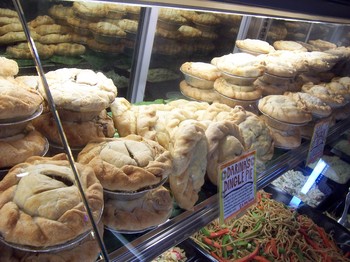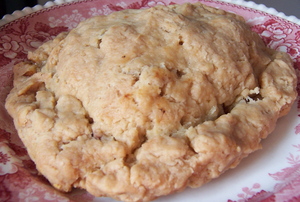An ode to pot pie!

Zingerman's Deli offers classic pot pies through the end of February.
Corinna Borden | Contributor
The pot pie is just one term to describe the phenomena of hot food enclosed in a crust. So when I say pot pie, I am addressing the full gambit of what that can mean all over the world:
• The Cornish pasty - an enclosed crust filled with steak, potato, and onion.
• The South American empanada - an enclosed crust filled with chicken, chorizo, raisins, and olives.
• The Arabian Sfeeha - an open pastry filled with lamb, tomato, cinnamon, and cardamom.
• The American pot pie - an open or enclosed crust filled with chicken, carrots, and peas.
For me, the Zingerman’s pot pie is a harbinger of the new year. Yet little did I know that there was so much history to this pinnacle of comfort food.
I will focus on the Cornish pasty as the origin of our American pot pie. You may not know this, but the Cornish Pasty Association (yes there is one) has applied to the United Kingdom government for protected status. If this is passed the Cornish Pasty will join the ranks of Champagne, Parma Ham, Stilton, Roquefort, etc as food items with protected names.
Cornish pasties were the traditional food fed to coal miners. The point of the crust was to keep dirty hands away from clean food. Some pasties would be filled with both sweet and savory items so that you could eat your chicken first and then have applesauce for dessert. Nowadays we eat the crust as the dessert and leave the bifurcated pie to history.
The Cornish people who immigrated to the Upper Peninsula in the middle of the 19th Century to work in the Michigan copper mines brought the pasty with them. If you are in the UP in late June, the Calumet PastyFest will be June 25 & June 26th. It looks like there are tons of options to choose from and enjoy.
One can find pot pie recipes ranging from “take frozen vegetables and condensed chicken soup” to “this is where the oysters are on your turkey.” Martha Stewart has one for Italian pot pie including biscuits and rosemary. I think that my favorite recipe is the same one I use for risotto, i.e. what do I have in my fridge?

The best part of eating a pasty - every bite includes crust.
Corinna Borden | Contributor
Last night I mixed leftover cream of broccoli soup with potatoes and chicken and put it into one bowl (for a pasty). Into another bowl I put leftover venison, sauteed onion, raisins, and blackcurrant vinegar (for a pseudo empanada). I made my mother-in-law's recipe for pie crust minus the sugar (which she can recite from memory) - 1 1/2 cup flour, 1/2 cup oil, 3 tablespoons milk, 1/2 teaspoon salt, 1/2 teaspoon sugar.
I free formed the crust around the fillings and baked for 45 minutes at 350 degrees. The leftovers were transformed into 100% winter comfort food - pie crust cookies surrounding savory warmth.
Drop me a line! Check out my website! Read my book! Post a comment and start the conversation rolling!


Comments
crumpet
Tue, Jan 26, 2010 : 8:44 a.m.
A Cornish pasty requires rutabaga, a highly underrated and delicious root vegetable. Grandma Crump always used handfuls of chopped parsley, as well.